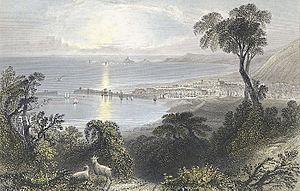Swansea Bay facts for kids

Swansea Bay (Welsh: Bae Abertawe) is a large bay on the southern coast of Wales. Several rivers flow into the bay, including the River Neath, River Tawe, River Afan, River Kenfig, and Clyne River. The bay and the nearby Bristol Channel have very large tides, meaning the water level changes a lot between high and low tide. Important shipping ports in Swansea Bay include Swansea Docks, Port Talbot Docks, and the wharfs at Briton Ferry.
Each part of the beach in Swansea Bay has its own name:
- Aberavon Beach
- Baglan Bay
- Jersey Marine Beach
- Swansea Beach
- Mumbles Beach
Contents
What is the History of Oyster Fishing in Swansea Bay?
Oyster fishing was once a very important business in Swansea Bay. In the 1860s, about 600 people worked in the oyster industry! However, by 1920, the number of oysters had almost disappeared. This happened because too many oysters were caught, and also due to disease and pollution in the water. In 2005, there were plans to bring back Oyster farming to the bay.
How Has Swansea Bay Been Affected by Pollution?
For about 20 years at the end of the 1900s, Swansea Bay had a big problem with pollution. This pollution came from nearby factories and also from sewage pipes that let out dirty water in the wrong places. The main sewage pipe was located near Mumbles Lighthouse. A special pumping station inside the cliff sent all of Swansea city's untreated dirty water to this spot.
The natural water currents in the bay made the problem worse. The dirty water often stayed in the bay instead of flowing out to sea. When the tide went out, the sewage didn't just go down the Bristol Channel. Instead, it would get pulled around the bay first. If it didn't fully leave on that tide, the incoming tide would push the same dirty water back up the Channel, making it circulate around the bay again. Local authorities tried to clean up the bay, but they had to be careful not to move the pollution to the popular beaches in south Gower.
The old sewage pipe was finally closed around 1996. A new, much longer pipeline was built. It followed the path of the old Mumbles Railway and went through Swansea Docks to a new £90 million sewage treatment plant at Crymlyn Burrows. From this plant, a new pipe was built that went much further out to sea. Because of these big improvements, Swansea Bay has become much cleaner. Aberavon beach even received Blue Flag status in December 2007, which means it meets high standards for water quality and safety.
How is Power Generated in Swansea Bay?
Swansea Bay and the surrounding area are involved in different ways of making electricity.
What are the Fossil Fuel Power Stations?
There is one gas-fired power station already working at Baglan Bay. Another gas-fired power station, called "Abernedd Power Station," has been approved to be built.
Are There Plans for Biomass Power?
A new biomass power station has been approved for construction near the coast at Port Talbot. Biomass power stations use organic materials, like plants, to create electricity.
What are the Tidal Power Plans?
The Bristol Channel, which includes Swansea Bay, has some of the biggest tides in the world. This means there's a lot of potential to make electricity from the moving water. A company called Tidal Lagoon Swansea Bay Ltd. has suggested building a tidal lagoon. This lagoon would be built south of the Queen's Dock, between the River Tawe and River Neath rivers.
This project is a bit controversial. One reason is the amount of money needed to make the project work. Another concern is the possible damage to a beautiful area in Cornwall, where the company wants to get rocks for the lagoon from an old quarry. This area is a protected AONB and MCZ.
Are There Plans for Wind Power?
Besides tidal power, plans for an offshore wind farm in the bay were approved. However, building the wind farm has been put on hold because of the high costs. The wind farm was planned to be at Scarweather Sands, about 3 miles (5 km) off the coast, and it would have been visible from Porthcawl.


